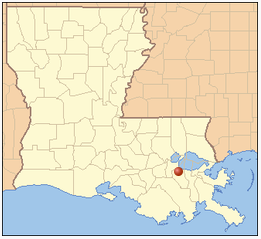| Home | Search | Emissions | Pollutants | About the Database |

Motiva Enterprises (1406), Norco
LDEQ Accident Report
| Accident # | 145845 |
| State Police # | NIG |
| Accident Date | 2013-01-10 |
| Report Date | 2013-01-15 |
| Follow-up Date | 0000-00-00 |
| Follow-up: | No |
Pollutants Released
| Pollutant | Duration | Point Source | Greenhouse Gas | Criteria Pollutant | Ozone forming chemical | Amount of Release |
| Stormwater | 2d 25m | Spillway on Northern side of SWIB | NO | NO | NO | BRQ |
Accident Classified As: No Information Given
Cause of Problem: Weather
On January 10, 2013, the Norco area experienced extremely heavy rains from a slow moving thunderstorm. The site was initially able to contain the rainfall associated with this event and route it the Refinery Wasterwater Treatment System (RWTS) for treatment and subsequent discharge through LPDES Outfall 002. However, the system storage capacity was reduced due to the amount of heavy rainfall that had occurred in such a short time frame and the rainfall events that had occurred on days preceding January 10, 2013; as the heavy rains continued, the RWTS (consisting of the Storm Water Impoundment Basin and Aeration Basin) reached maximum capacity levels. In accordance with the procedures outlined in the LPDES permit application, Motiva opened the spillway, which is located on the northern side of the SWIB, at 14:35 to prevent flooding of the refinery and damage to the SWIB from overtopping of the retaining levee. The spill was discharged until approximately 3:00 PM on January 12, 2013 into Engineers Canal which then flows into Lake Ponchartrain. Sampling and visual observations were conducted in conjunction with opening the spillway, no signs of adverse water quality of the storm water discharge during this bypass.
Discharge Preventable - No
The unanticipated bypass incident at the Sotrm Water Impoundment Basin spillway was due to an upset condition as defined by LAC 33:IX.2701.N.1., and was caused by thunderstorms and associated heavy rainfall.
Notes/Remedial Actions
As stated above, Motiva's normal operating procedures call for the initiation of bypass operations when no capacity remains in the RWTS and a bypass is the only alternatives to prevent flooding of the facility. According to the follow up letter effluent limits established in the permit for this bypass procedure were not exceeded and there were no visual signs of adverse water impact.

Connect With Us: